The apartheid divestment movement at George Washington University: the legacy of student activism and GW Voices for a Free South Africa
IF 0.2
Q4 AREA STUDIES
Safundi-The Journal of South African and American Studies
Pub Date : 2020-09-10
DOI:10.1080/17533171.2020.1796471
引用次数: 0
Abstract
ABSTRACT The antiapartheid protests at George Washington University were the campus’s largest student protests since the Vietnam War. As at other universities, students advocated divestment of university finances in businesses with operations in South Africa, including through the now-iconic “shantytown” protests, which symbolized South African living conditions on campus. Under pressure from a student group, GW Voices for a Free South Africa, university leadership under President Lloyd Elliott seriously considered moving the University’s stock portfolio to a South Africa-free fund but ultimately decided such a fund was too risky. Unlike other universities of its size and prestige, GW never divested. The location of the University and the size of its South African-affected stock holdings hampered divestment efforts.乔治华盛顿大学的种族隔离撤资运动:学生激进主义和乔治华盛顿大学自由南非之声的遗产
乔治华盛顿大学的反种族隔离抗议活动是该校自越南战争以来规模最大的学生抗议活动。与其他大学一样,学生们主张从在南非开展业务的企业中撤资,包括通过如今已成为标志性的“棚户区”抗议活动,这象征着南非人在校园里的生活条件。在学生团体“自由南非之声”(GW Voices for a Free South Africa)的压力下,校长Lloyd Elliott领导的大学领导层认真考虑将大学的股票投资组合转移到一个无南非基金,但最终认为这样的基金风险太大。与其他同等规模和声望的大学不同,乔治华盛顿大学从未撤资。该大学的位置及其持有的受南非影响的股票的规模阻碍了撤资努力。
本文章由计算机程序翻译,如有差异,请以英文原文为准。
求助全文
约1分钟内获得全文
求助全文
来源期刊
CiteScore
1.00
自引率
0.00%
发文量
0

 求助内容:
求助内容: 应助结果提醒方式:
应助结果提醒方式:


